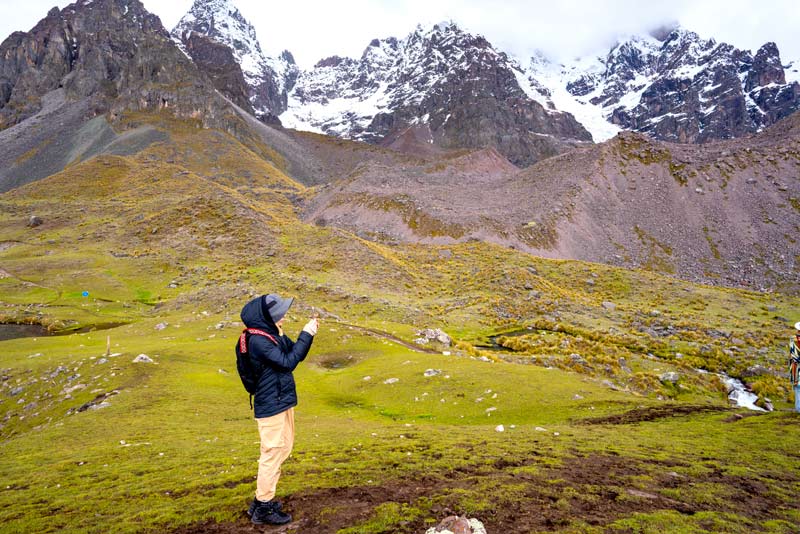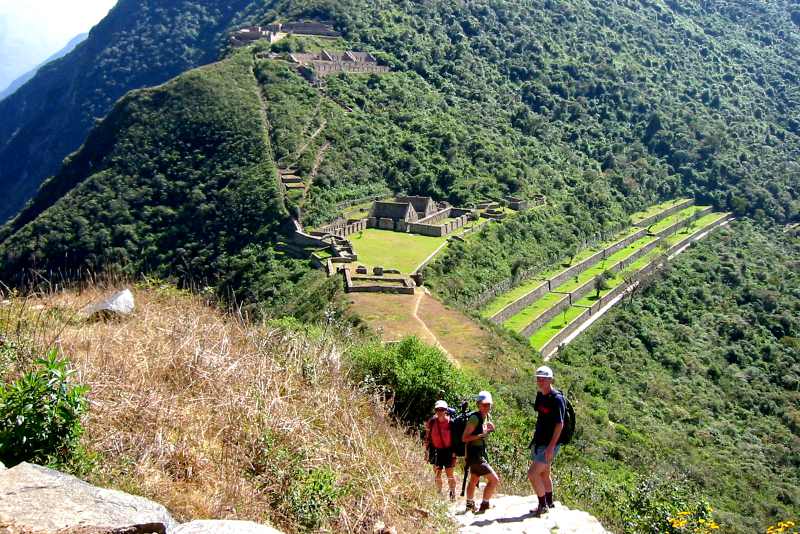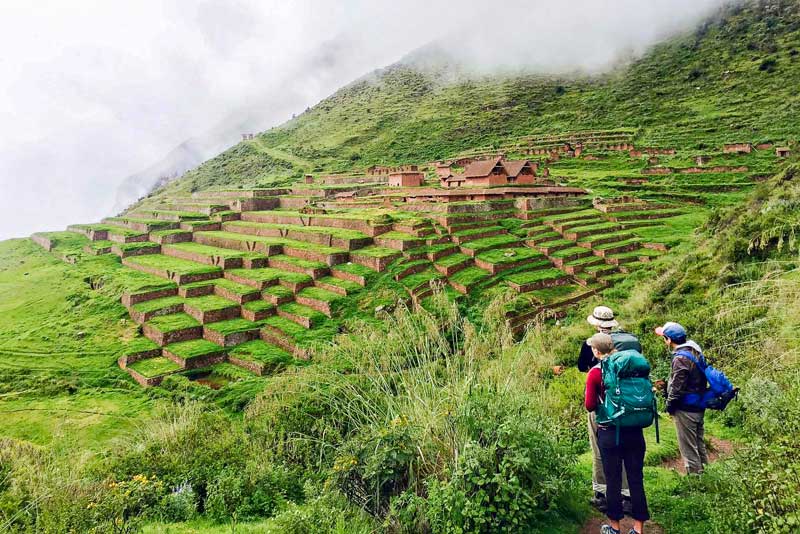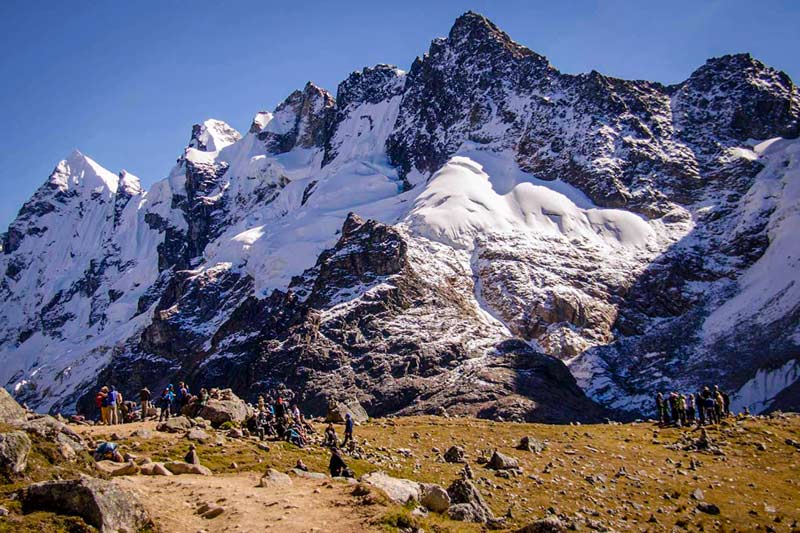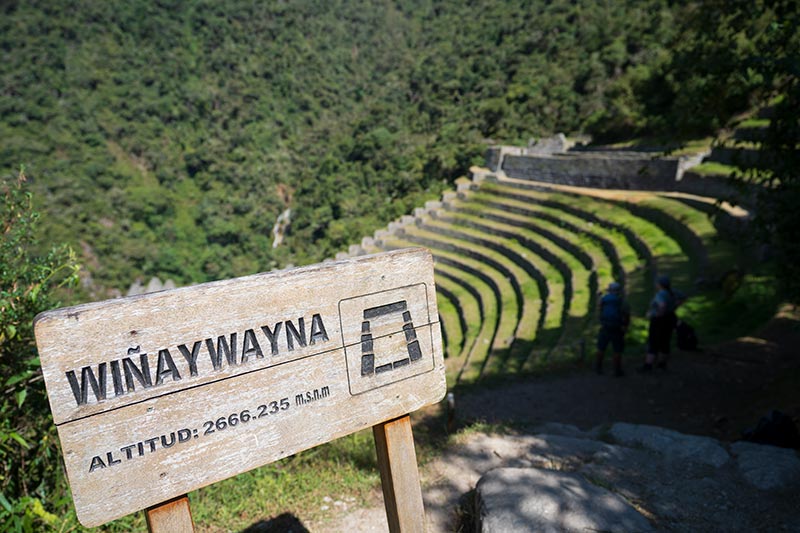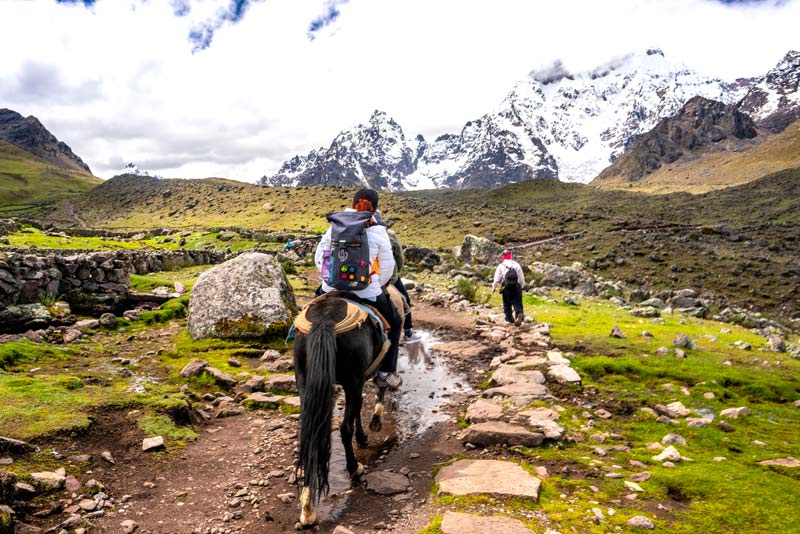The best trekking routes in Cusco
Trekking or hiking on your trip to Cusco is one of the most impressive activities. Located in a geographical landscape unique in the world, the Cusco region allows you to discover breathtaking landscapes on hikes that will become unforgettable experiences. From snow-capped peaks, treks through jungle, to valleys that allow you to discover the vast biodiversity waiting to surprise you. Learn about the best options available and make your trekking trip in Cusco a memorable one.
- What are the trekking routes like in Cusco?
- What are the best trekking routes in Cusco?
- Choquequirao Trekking
- Trekking to Huchuy Qosqo
- Trekking through the Salkantay Snow-capped Mountain
- Inca Trail Trekking
- Trekking through the Nevado Ausangate
- Comparative table of hikes in Cusco
- Recommendations for your trekking in Cusco
- Frequently Asked Questions
What are the trekking routes like in Cusco?
The Cusco region is located in a privileged location, right in the heart of the Andes mountain range, the longest in the world (approximately 7,000 kilometers) and runs through Peru from north to south. Thanks to this mountain range, we’ll find a wide variety of altitudes within Cusco, boasting abundant biodiversity and unique microclimates. We’ll see glaciers, punas, forests, and even highland rainforest all in one route.
Thanks to the Andes mountain range, Cusco is home to many deep valleys, snow-capped mountains, canyons, and jungle ridges. On routes that can last from a day to more than a week, each one is a constant wonder, where you’ll encounter the most beautiful landscapes anywhere.
Thanks to the presence of the Andes mountain range, the concentration of magical archaeological sites, its vast culture, and its breathtaking landscapes, Cusco is one of the best destinations in the world for trekking or hiking.
Trekking in Cusco with Boletomachupicchu
If you want to explore the trekking routes of Choquequirao, Huchuy Qosqo, Nevado Salkantay, and the Inca Trail, remember that you can discover them all thanks to Boletomachupicchu with incredible, safe tours that will make your experience easier. These tours will connect you with history, with places full of culture, indescribable landscapes, and unique emotions that you will experience while experiencing each of these experiences. From one-day hikes to five-day treks, each of these adventures will allow you to experience an unforgettable angle of the Cusco region. Don’t miss this opportunity on your trip to Cusco to discover all the landscapes and adventures that await.
What are the best trekking routes in Cusco?
Within Cusco, you’ll find a wide variety of trekking options, each with varying levels of difficulty and microclimates that will allow you to find the best option for your adventures. For this reason, we’ll recommend some of the most impressive treks to make your trip to the Cusco region one of the best experiences of your life.
Choquequirao Trekking
The Choquequirao hiking trail is one of the most iconic. Choquequirao is an Inca archaeological complex perched on a mountaintop. Its architecture is so similar to Machu Picchu that they are often referred to as “siblings.”
The hike lasts four days and covers approximately 62 kilometers round trip. It is considered highly difficult due to its rugged trails and steep gradients. This makes for a great adventure with many scenic and experiential rewards, bringing with it great satisfaction and lasting memories.
The hike begins in the town of Capuliyoc, a four-hour drive from Cusco. From here, we’ll walk for two days until we reach the Choquequirao archaeological complex. During the hike, we’ll witness a great diversity of landscapes, traversing the mountainous terrain of the Apurímac River canyon and jungle trails, where the journey begins to get more intense. The third day is dedicated to exploring the landscape, before returning along the same path.
The Choquequirao archaeological complex allows you to enjoy the Inca legacy, surrounded by a landscape surrounded by abundant biodiversity; you’ll feel like you’re in a hidden paradise.
Trekking to Huchuy Qosqo
The Huchuy Qosqo trek is one of the best adventures you can experience in two days and one night. Huchuy Qosqo (Little Cusco) is an archaeological site dating back to the Inca period with a wealth of attractions to explore.
Huchuy Qosqo is located high on a mountain, from where we can see the entire Sacred Valley in all its splendor. The hike begins in Tambomachay, a 25-minute drive from Cusco. From here, we begin the approximately 17-kilometer hike with gentle climbs.
The hike to Huchuy Qosqo is considered moderate, as the trek can take up to five hours to reach Huchuy Qosqo from Tambomachay. The ideal route is to spend the night in the campsite and then continue the next day on a gentle two-hour hike to the town of Lamay.
Huchuy Qosqo offers you the opportunity to learn more about Inca buildings and their legacy, while enjoying a long, but less difficult, hike. The landscapes you’ll encounter will make the adventure completely worthwhile.
Trekking through the Salkantay Snow-capped Mountain
The trek up the Salkantay Mountains to Machu Picchu is probably the most incredible and comprehensive trek you’ll find in the Cusco region. Along the way, you’ll visit iconic Cusco sites such as the Salkantay Pass, Humantay Lagoon, Santa Teresa, and the wonder of Machu Picchu.
The trek lasts five days. It begins in the town of Soraypampa, where we’ll explore Laguna Humantay, a natural wonder at the foot of the snow-capped mountain of the same name. During the first two days of the trek, you’ll also visit the Salkantay Pass, with breathtaking views that will leave you breathless.
On the third day of the trek, we’ll arrive at the town of Santa Teresa, where we can take a break in the hot springs of Cocalmayo, a must-see destination surrounded by incredible biodiversity. The hike then continues along the hydroelectric route to reach Aguas Calientes and our final destination, Machu Picchu.
Throughout the trek through Nevado Salkantay, we’ll appreciate a vast diversity of landscapes, from snow-capped peaks, plains, valleys, and places with abundant jungle fauna from Santa Teresa—definitely a hiking trip that has absolutely everything.
Inca Trail Trekking
One of the most popular and memorable trekking routes is the Inca Trail , which connects you to the wonder of Machu Picchu. It’s a journey steeped in history where we’ll visit iconic sites, perfect for pausing and appreciating their grandeur and beauty.
The hike covers approximately 40 kilometers in four days. The Inca Trail is considered difficult, but it has many rest stops, which can make it somewhat easier. However, you will encounter steep stretches and many descents.
During the Inca Trail, we can enjoy starry skies, mountaintop landscapes, and archaeological sites such as Sayacmarca, Llactapata, Phuyupatamarca, and Wiñayhuayna.
The hike begins at kilometer 82 of the Ollantaytambo railway, covering 14 kilometers on the first day, 16 kilometers on the second day, and 10 kilometers on the third day. It ends at the Inti Punku (stone gate) with a beautiful view of Machu Picchu.
Trekking through the Nevado Ausangate
The trekking route through Nevado Ausangate offers the greatest natural landscapes. On routes with minimal human intervention, we’ll find almost pristine views with attractions such as glaciers, colorful lakes, snow-capped mountains, multi-colored mountains, and a wide variety of flora and fauna.
The tour lasts four days, covering an average of 40 kilometers. Along the way, we’ll pass by must-see sites such as the Pukacocha and Yanacocha lagoons, among many others. We’ll also visit the Salkantay Glacier and finally Rainbow Mountain, next to the Red Valley.
The hike begins in the town of Pacchanta, a three-hour drive from Cusco. From here, we’ll follow highly difficult trails in very cold climates. But that’s only a hint of what a great adventure it will be; the landscapes we’ll see are the most impressive in Cusco, where you’ll feel tiny compared to the giant mountains and snow-capped peaks.
Comparative table of hikes in Cusco
| Trekking Route | Duration | Physical difficulty | Maximum altitude | Landscapes | Main attractions | Tourist influx |
|---|---|---|---|---|---|---|
| Choquequirao | 4 days | High | 3,150 meters above sea level (Choquequirao) | Deep canyon, jungle eyebrow, dry forests. | The Inca citadel of Choquequirao, the Apurímac canyon, snow-capped peaks and humid jungles. | Low |
| Huchuy Qosqo | 2 days | Low – medium | 4,200 meters above sea level (Pukamarca Pass) | High Andes, Andean villages, views of the Sacred Valley . | Huchuy Qosqo archaeological site, Qoricocha lagoon, and a stunning view of the Sacred Valley. | Very low |
| Salkantay | 5 days | High | 4,650 meters above sea level (Salkantay Pass) | Snowy mountains, lagoons, high jungle. | The Humantay lagoon, the Salkantay snow-capped mountain, the town of Santa Teresa and Machu Picchu. | Average |
| Classic Inca Trail | 4 days | Medium – high | 4,215 meters above sea level (Abra Warmiwañusca) | Cloud forests, Inca staircases, high jungle. | Inca Trails, Wiñayhuayna and Machu Picchu. | High (advance reservation required) |
| Ausangate | 4 days | Very high | 5,100 meters above sea level (Palomani Pass) | High mountains, glaciers, multicolored lagoons. | Lagoons, glacier and snow-capped Ausangate, the mountain of 7 colors. | Low |
Recommendations for your trekking in Cusco
- Before embarking on any of the trekking routes in Cusco, acclimatize during the first few days to avoid altitude sickness and better enjoy your trip.
- Visiting each of these destinations with a tour or guide will enrich your experience, providing you with greater comfort and security than you would find if you went on your own.
- Remember to stop on your walks to fully appreciate every angle of the buildings and nature you see to feel more present in your journey.
- Bring plenty of water or purification tablets; they are essential for long treks. Hydration is the most important step on trekking routes.
- Take advantage of the opportunity to take a break from your routine and reflect amidst beautiful landscapes.
- Stay in a state of gratitude to the earth and Pachamama for allowing you to be safe on your trip, enjoying totally unforgettable landscapes and experiences.
- Your cell phone’s battery could die, so it’s highly recommended to carry a notebook where you can write down your experiences, to make your journey along the best trekking routes in Cusco last forever.
- Each of the routes can be modified in length; you may want to extend or shorten them; all options are suitable for this type of trekking.
- Visit any of these tours during the dry season (April through October) for the best weather, but for more adventure, any time of year is perfect.
- Always stay warm and wear rain gear, as the weather in Cusco can be very unpredictable.
- If you’re planning to explore Machu Picchu via the Inca Trail, we recommend prior acclimatization and good physical condition, as the trek will climb to an altitude of 4,200 meters above sea level. The Inca Trail can be one of the highlights of your trip to Cusco, so prior preparation is essential.
Frequently Asked Questions
1) What is the difficulty level of the hike to Choquequirao?
The hike to Choquequirao is considered highly difficult. It involves long trails across rugged terrain with steep slopes. The reward is as great as the effort, as you’ll see landscapes of the Apurímac Canyon, jungle trails, and an Inca citadel very similar to Machu Picchu.
2) How many days does the hike to Choquequirao take?
This classic trek lasts an average of four days and three nights, although extended versions are also available. The hike covers approximately 62 kilometers (round trip) from the starting point in Capuliyoc. The typical itinerary includes two days of hiking to reach the citadel, a full day to explore the archaeological complex, and a further day to return.
3) What is the best time of year to go trekking in Cusco?
The best time to go trekking in Cusco is during the dry season, between April and October. During these months, the weather is more stable and the rains are less frequent, making it easier to travel the trails and enjoy the scenery more fully. However, if you’re looking for a more adventurous experience, it’s also possible to do so during the rainy season, though you’ll need to be prepared with good equipment.
4) What is the most challenging hike in Cusco?
The Choquequirao hike and the Ausangate Snow-capped mountain hike share this location. The former involves long ascents and descents through canyons and valleys, while the latter combines high altitudes with extreme cold climates and high mountain trails.
5) What is the best hike in Cusco if I want to avoid crowds?
The route to Huchuy Qosqo and the hike to Choquequirao are gems less explored by mass tourism. Choquequirao, in particular, is a solitary and mystical experience, ideal for those seeking to reconnect with nature.
6) What route do you recommend if I only have a few days in Cusco?
If your time is limited, choose the Huchuy Qosqo hike (2 days and 1 night) or a mini trek to the Humantay Lagoon.
7) What is the most complete hike in terms of landscape diversity?
The Salkantay Snowy Mountain trek. In just 5 days, you’ll travel from towering snow-capped peaks like Salkantay, to glacial lagoons like Humantay, forests, tropical zones, and finally, you’ll reach Machu Picchu. This is a perfect route for those seeking a complete trekking experience.
8) Is it necessary to hire a tour or guide to go trekking in Cusco?
While most hikes are possible on your own, the experience is enriched by being accompanied by a professional guide or by taking a tour. These provide you with logistical security (transportation, camping, meals), allowing you to focus solely on enjoying the hike.
9) What equipment or clothing is essential for trekking in Cusco?
Among the essentials: thermal clothing, a waterproof jacket, sunscreen, sunglasses, a hat for the cold and one for the sun, a good flashlight, plenty of water, water purification tablets, and a personal first-aid kit.
10) How can I acclimatize before hiking in Cusco?
Proper acclimatization is key to avoiding altitude sickness. Ideally, upon arriving in Cusco, you should spend the first two days resting, hydrating well, avoiding intense physical exertion, and choosing light foods.
Advice from people who have been there
 By: Gonzalo H.
By: Gonzalo H.“Adventure in Cusco“
“I did not know how amazing Huchuy Qosqo would be, the hike was not so complicated, but it was a little long. From the archaeological center we were able to spend the night, the starry night was the best thing I saw, the scenery was breathtaking. The next day we returned to the sacred valley and it was spectacular, two days well spent.“
By Ticket Machu Picchu – Last updated, April 11, 2025
